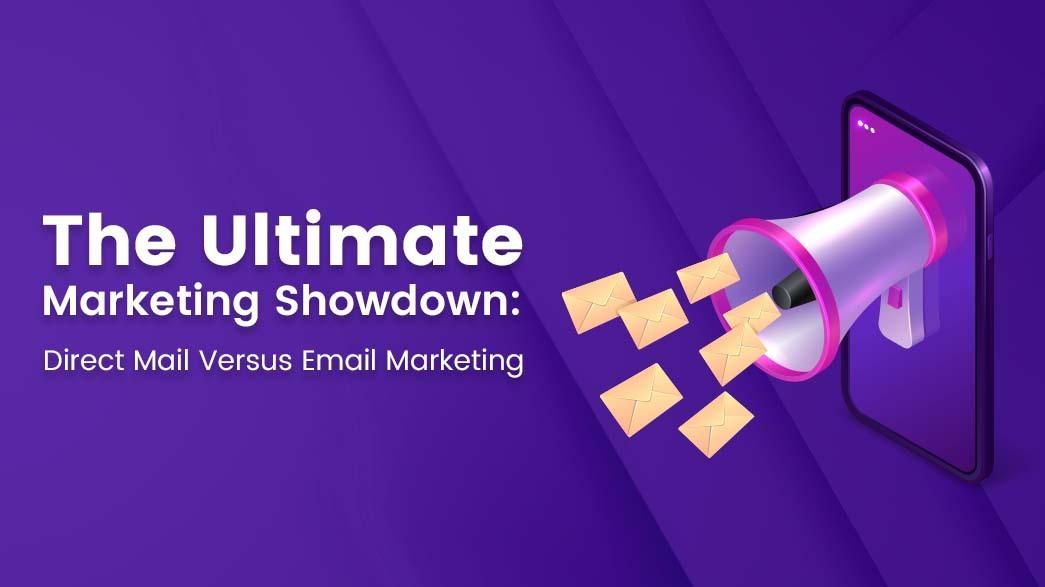
The Ultimate Marketing Showdown: Direct Mail versus Email Marketing
Which one is better?
Email Marketing
Which one is better?
Published:
Email Marketing
Wajeeha Gull
Share

Businesses today must rush to reach their customers as effectively as possible. But when it comes to choosing the right medium, things can get a little tricky.
This is where the hot debate comes in: should you stick to traditional methods like direct mail marketing or take the modern route with email marketing campaigns? Safe to say, there are plenty of different marketing channels out there and when you're a new business, designing campaigns might seem like a challenge.
But before you can make an informed decision, first get to know reliable mediums for optimizing customer communications and how they can help your business grow.
Also Read: Catchy Subject Lines for Sales and What You Are Doing Wrong
Direct mail is an age-old marketing medium that relies on conventional outreach. Simply put, a direct mail piece goes through a postal service before reaching a prospect's doorstep. This type of tangible correspondence includes flyers and brochures, or anything within the marketing context on print.
Contrary to popular belief, direct mail is far from dead. It has been used for decades, and rightfully so. Yet, email campaigns are the digital alternative many marketers focus on today.
Email marketing is the process of contacting your prospects through email - through the Internet-and consists of long drip campaigns, announcements, and all sorts of other marketing messages that are designed to push the user through the buyer journey.
Naturally, each has its benefits. However, common misconceptions entail that people often discount the advantages of traditional direct mail.
In reality, direct mail campaigns can be the superior choice in many circumstances. As long as your approach to the tangible way puts customers at the center, results can be promising.
Let's be honest, how many times have you been ghosted by email recipients? No matter how great a business may be, none can respond to this question with a 'zero'.
For instance, when chasing leads in the B2B world, you can't replicate B2C marketing strategies and expect the same results. Reaching out to business customers requires a completely different perspective.
Similarly, understanding the type of communication your client considers more impactful is essential.
Imagine selling back braces to senior citizens through email. The older generation doesn't regularly check who's sending messages to their electronic mailing address. So, if your business reaches out to them through mismatched avenues, turning a profit might as well be a pipe dream.

With printed marketing materials, you have the luxury of adding more information supported by attractive visuals. This is why, for example, exclusive fashion retailers send catalogs of their seasonal collections to consumers through direct mail.
You might be surprised to learn that email response rates are drastically lower than those of direct mail. In fact, the Postary reports up to 4.4 % response rate for traditional marketing compared to 0.6% for email marketing.
More businesses today are re-embracing print marketing with a passion due to its longer average lifespan. Naturally, to convert leads and earn a sale, a potential client must first reply to your brand messages.
On the other hand, designing an email marketing campaign is obviously easier than managing direct mail. And since businesses can virtually send unlimited emails at very little cost, traditional marketing methods simply cannot compete when it comes to ROI.
In money terms, email and direct mail both yield pleasant results. Except for that email marketing averages around 4 times the return compared to its traditional counterpart.
While email marketing and direct mail marketing are both used for the same purpose, they're anything but perfect alternatives. If you're convinced they're one and the same, it's time to debunk that misconception right away.
Consumers don't perceive email messages the same as direct mail messages. Both have a unique impact on the recipient, and that's what truly matters.
Put yourself in the shoes of the customer - you're more prone to opening an email marketing piece on the go or when you're already occupied with other things. However, opening direct mail that's neatly tucked inside envelopes is something most people reserve for the end of the day. A time when there are less distractions allowing for greater brand recall.
By mapping out the buyer's journey like this, businesses can better understand how email and direct marketing are two sides of a vast spectrum.
However, there are benefits of email marketing over direct mail, and they can't be ignored.
With automated email marketing tools, tracking conversions just takes a few taps on the screen. Simply head over to your dashboard and check metrics like open rates and click-through rates. To top it off, you can easily see recipients who actually viewed messages to curate customised follow up strategies.
At the other end, the success of your direct mailing campaigns can only be verified when customers respond. If only modern marketers using traditional tactics could somehow know whether recipients looked through their brand's printed messages, life would be a whole lot easier.
Email marketing allows businesses to build massive email lists even with a limited marketing budget. In the virtual world, you don't have to jump over hoops to collect email addresses. Just provide an incentive in exchange for their contact details.
For example, many businesses offer a 10% discount to customers who sign up for their newsletter. Within days, if not weeks, they're able to create a decent subscriber list as sign-ups flow in.
Not to mention, direct mail and email marketing have a very stark difference. One is geographically limited whereas the other makes national boundaries invisible. The power of email enables brands to capture customers from across the globe!
Manually sending out emails in the 21st century is a big no. There are plenty of amazing technologies out there to make the process easier. In other words, automating your email marketing campaigns is not only possible but also the recommended choice.
You can send emails everyday and you can engage your subscribers in content, new offers, or whatever you would like to remind them of in drip campaigns.
But the same cannot be said for direct mail. Traditional methods, no matter how beneficial, aren't as fast as digital ones, and cannot be automated.
Nothing speaks louder than personalized messages. Individuals today tune out most of the information they receive. For a brand to actually get noticed, its emails must reflect some soul, at the least. And companies that don't hesitate to get personal often come out at the top for good reason.
With direct mail, unfortunately, businesses don't have much leeway. You cannot tweak the content of your print media according to every new person reached whereas, simply modifying the subject line of an email can make all the difference.
By analyzing customer patterns across gender, age, working status, and many more demographics, you can reduce the chances of sending mismatched messages.
Crack the code on forgetful prospects with email follow-ups after sending direct mail.
Email reminders provide that extra push for customers to take action, especially when it's through a differentiated medium. Not only does it help brand identity but also strengthens brand recall.
This is especially true of the younger demographic. While Gen Z clients may not convert after receiving a catalogue in the mail, they will be much more likely to check your online presence after reading that follow up message.

In some cases, direct mail supersedes email marketing. Here is how.
Earning the trust of a customer isn't always easy, but it's not an impossible feat when companies play their cards right. If someone contacts your business in the hopes of a partnership, you won't just add them to your list of options after sifting through a brief email. The difference between direct mail and email campaigns isn't just content length. but what's in that content and how it is delivered.
Direct mail pieces work better because they're able to cover important points an email simply cannot - or should not - go over in detail. This is closely linked to the trust factor.
For instance, B2B brands tend to trust tangible mail that addresses not just one or two, but many of their pain points. The fintech industry serves as a great example. Ironically, direct mail works quite well here. In an industry where big money is an everyday thing, emails don't get the job done. People signing hefty checks need more than just an electronic message, they demand proof, and print provides the latter effortlessly.
You can go above and beyond yet there will always be recipients who won't respond to emails. But just because they don't send a reply, doesn't mean they will never convert.
Some people are just email non-responders and thus, the best way to let them know of your brand is through direct mail. Let's go back to the senior citizen example quoted earlier in this article.
As a business operating in this niche, sending emails is a wasted effort. When you know your prospect isn't tech-savvy, why not focus your business's energy on a medium that actually resonates with its target market?
When pitching to busy executives and CEOs, the best way to get your message across might not be through email. Why? Because capturing the attention of important decision-makers demands a bit more elbow grease than is reflected via email - a medium that is so familiar to people of power that it's downright boring!
Remember, you want to cut through the noise, not get drowned in it. If executed correctly, direct mail can deliver greater value and make a stronger impact.
The dilemma: direct mail or email marketing. Why not direct mail AND email marketing Limiting your business to a single channel is a massive mistake you should never make. Depending on the situation, direct mail can effectively complement digital marketing.
In a world where people are bombarded with hordes of messages every day, omnichannel marketing doesn't just rule, it conquers. The matter of fact is that direct mail is making a comeback because customers like being reached through multiple channels. And companies that recognize this are bound to convert prospects into loyal customers.
Safe to say, a direct mail campaign can supplement social media communications, email marketing, and more!

Direct mail marketing is no joke, it's backed by results and worth the additional effort. Brands that complement email marketing with traditional methods have greater chances of reaching maximum potential.

Reach more customers with your cold emails
Table of Contents
In a nutshell

Subscribe to our Newsletter!
Digital advice costs money but we send it to
your inbox for free.

Related Blogs


Book a quick demo of our email marketing tools and watch as we transform your leads into loyal customers.

![A loop illustration w-auto h-[70px]](/_next/image?url=%2F_next%2Fstatic%2Fmedia%2Fvector1.7738e6de.png&w=256&q=75)
Get in touch
Subscribe to our weekly Newsletter and receive updates via email.